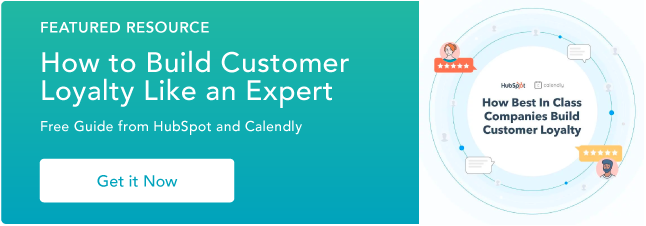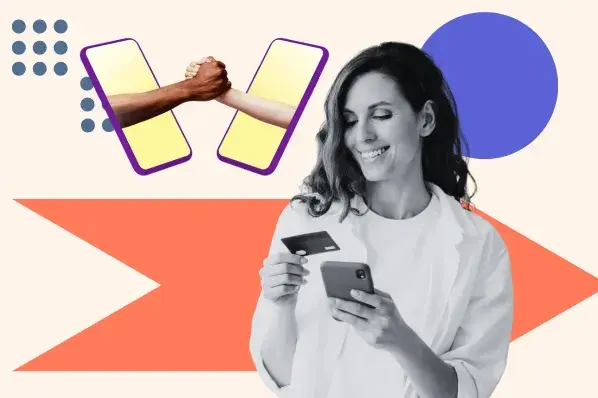Having a strong customer loyalty strategy can greatly aid brand success. Customers are 50% more likely to try a new product of yours as well as spend 31% more than new customers. Conversely, it costs six to seven times more to acquire new customers than it does to retain current customers.

Whether or not you currently have a customer loyalty program that encourages your customers to return and conduct more business with you, the above statistics clearly show the importance and impact of a successful customer loyalty strategy.
In this guide, you'll discover everything you need to know about customer loyalty and how to create a successful customer loyalty program.
Chapters
Let's kick things off by defining customer loyalty.
What is customer loyalty?
Customer loyalty is a customer's willingness to repeatedly return to a company to conduct business. This is typically due to the delightful and remarkable experiences they have with that brand.
One of the main reasons to promote customer loyalty is because those customers can help you grow your business faster than your sales and marketing teams. There are several other reasons why customer loyalty is critical to your success.
Why is customer loyalty important?
Customer loyalty is something all companies should aspire to simply by virtue of their existence: The point of starting a for-profit company is to attract and keep happy customers who buy your products to drive revenue.
Cultivating customer loyalty is similar to creating fans. These are customers who are already engaged and can help you gain more business. Just like you know when your favorite band is going on tour or releasing a new project, loyal customers are in tune with what their preferred brands are doing.
They may follow you on social media or subscribe to your newsletter to stay in the loop about new products or updates. This is why customer loyalty marketing is crucial to your brand’s strategy. You already have a built-in fanbase. You’ll need to continue to delight those repeat customers to reap the benefits.
Customer Loyalty in Marketing
Building customer loyalty should be top of mind when creating your brand’s marketing strategy, as loyal customers are happy customers. Customer loyalty will also aid in customer retention. Here are a few additional benefits customer loyalty marketing provides.
Increased Share-of-Wallet
Share-of-wallet refers to the amount of money a customer spends on a certain brand compared to how much they spend on the brand’s competitors. Customers convert and spend more time and money with the brands to which they're loyal. That’ll mean more share-of-wallet for you.
Better Word-of-Mouth Referrals
Customers convert and spend more time and money with the brands to which they're loyal. These customers also tell their friends and colleagues about those brands, too which drives referral traffic and word-of-mouth marketing.
Increased Trust
Customer loyalty also fosters a strong sense of trust between your brand and customers — when customers choose to frequently return to your company, the value they're getting out of the relationship outweighs the potential benefits they'd get from one of your competitors.
Since we know it costs more to acquire a new customer than to retain an existing customer, the prospect of mobilizing and activating your loyal customers to recruit new ones — simply by evangelizing a brand — should excite marketers, salespeople, and customer success managers alike.
But how do you do it? How do you turn happy, satisfied customers into loyal brand evangelists? How do you use positive Yelp reviews, glowing tweets, and Instagram mentions to propel your brand's growth?
Well, we have a few ideas.
How to Keep Customers Loyal
- Be as generous as your customers.
- Show your gratitude.
- Provide benefits to your customers with every purchase.
- Scratch the program completely.
- Build a useful community for your customers.
- Communicate effectively with your customers.
- Improve upon your customer loyalty program.
- Continuously evolve your business over time.
1. Be as generous as your customers.
From the outside looking in, customer loyalty programs can appear to be nothing more than a scheme to get customers to spend even more money. (Let's face it; we can all be cynics sometimes.)
That's why truly generous loyalty programs stand out among the rest.
If your loyalty program requires customers to spend a lot of money only to be rewarded with meager discounts and samples, you're doing it wrong. Instead, walk the walk and show customers how much you value them by offering perks that are so good, it would be foolish not to become a member.
2. Show your gratitude.
You might think that, by offering a loyalty program, you're expressing your gratitude for their business and loyalty. Think again. Your customers are routinely bombarded by businesses — your competitors included. Your competitors likely offer a loyalty program, too.
What sets you apart in a way that keeps customers loyal? Expressing your gratitude through handwritten notes or direct, one-to-one messages. Include thank you notes in your product deliveries or purchase confirmation emails, or send special cards around the holidays.
3. Provide benefits to your customers with every purchase.
Build loyalty by rewarding them for each purchase, or offering an incentive to purchase more. This could be a point system where a certain amount of purchases earns a discount or something else of value.
For example, Fabletics offers members of their VIP program points for every purchase. Those points can then be redeemed anytime for different merch tiers. Customers can choose to redeem points as soon as they qualify for the lowest tier or continue saving points to earn something from the higher tier, like an outfit.
4. Scratch the program completely.
Considering how many businesses offer loyalty programs, one innovative idea to make yourself stand out is to nix the idea of employing a "program" altogether. Instead, build loyalty by providing customers with awesome benefits related to your business and product or service with every purchase.
This minimalist approach works best for companies that sell unique products or services. That doesn't necessarily mean that you offer the lowest price, or the best quality, or the most convenience; instead, I'm talking about redefining a category.
If your company is pioneering a new product or service, a loyalty program may not be necessary. Customers will be loyal because there are few other options as spectacular as you, and you've communicated that value from your first interaction.
5. Build a useful community for your customers.
Customers will always trust their peers more than they trust your business. Between social media, customer review sites, forums, and more, the slightest slip can be recorded and uploaded for the world to see. But, you can turn this into a positive by managing a community that encourages customer-to-customer interactions.
One way to do this is with self-service support resources. If you have a knowledge base, you can add a community forum. A community forum encourages customers to communicate with one another on various topics, like troubleshooting the product or retelling service experiences. Even if they leave negative feedback, at least it's left on your domain where you can respond to it and deal with it accordingly.
A community forum can benefit your business in other ways, too — for example on the HubSpot Ideas Forum, customers can pitch ideas and upvote each other's posts. If the idea is good, the product team will consider it for an upcoming sprint. If the idea can already be done with the product, the support team will reach out with a solution. This lets our team provide both proactive and reactive customer service through one resource.
As online communities progress, you may formalize them to keep things organized. Having a consistent system in place ensures fairness and keeps customers satisfied over time.
This is where customer loyalty programs come in handy.
6. Communicate effectively with your customers.
Building and maintaining customers’ trust requires continuous communication. When a customer knows that your business is transparent and honest, they have trust that will have a positive experience in their interactions. This should still be the case especially when it comes to customer service and has a problem to be resolved.
Good communication means your customers should know what is going on with your business. If there is a new product, a major change, company update, shortage, change in hours, or anything that a customer should be aware of so they aren’t surprised, it should be clearly communicated. This is a part of good customer service that is essential for making customers want to continue doing business with you.
7. Improve upon your customer loyalty program.
While earlier we suggested forgoing the customer loyalty program, it’s still an essential cornerstone of any customer loyalty-building endeavor. It’s one of the best ways to build customer loyalty, especially if the brand keeps adding perks that make it impossible to walk away.
Companies provide customer loyalty programs to their most frequent customers to encourage loyalty and long-term business by offering free merchandise, rewards, coupons, or even advance-released products. Continue improving upon yours by offering more perks and rewards as time goes on.
8. Continuously evolve your business over time.
The market and the desires of your audience and customers are going to continuously change over time. Doing research and staying up-to-date in your industry reassures customers that you will always be innovative and offer the best options for meeting their needs. This doesn’t just apply to new technologies, though.
Evolving should include the branding, culture, marketing, and your product itself. Customers develop trust over knowing that companies won’t be stagnant. Being aware of how to continuously improve your business ensures you’re always getting better. Loyalty to your business and your products comes with customers knowing they’re always getting the best.
Free Download: How Best In Class Companies Build Customer Loyalty

What is a customer loyalty program?
Companies provide customer loyalty programs to their most frequent customers to encourage loyalty and long-term business by offering free merchandise, rewards, coupons, or even advance-released products.
So, how do you ensure your customer loyalty program is beneficial for your business and your customers? Check out the types of loyalty programs below.
How do loyalty programs work?
Gaining and retaining customers is the primary goal for businesses. A lot of marketing focuses on gaining customers but retaining them is often a whole different ball game. Loyalty programs work by giving customers an incentive to continue doing business with you. The incentives can be a variety of things, but they should offer a strong benefit to keep them coming back.
Types of Customer Loyalty Programs
- Point-based loyalty program
- Tiered loyalty program
- Paid loyalty program
- Value-based loyalty program
- Coalition loyalty program
- Game-based loyalty program
1. Point-Based Loyalty Program
This is arguably the most common loyalty program methodology in existence. Frequent customers earn points that translate into rewards such as a discount code, freebie, or another type of special offer. Where many companies falter in this method, however, is making the relationship between points and tangible rewards complex and confusing.
Poor option:
"Fourteen points equals one dollar, and twenty dollars earn 50% off your next purchase in April!"
That's not rewarding. That's a headache.
Better option:
Earn a point for each dollar spent. Get a 20% discount after earning 50 points.
If you opt for a points-based loyalty program, keep the conversions simple and intuitive. Although a points system is perhaps the most common form of loyalty program, it isn't necessarily applicable to every type of business. It works best for businesses that encourage frequent, short-term purchases, like Dunkin' Donuts.
2. Tiered Loyalty Program
Finding a balance between attainable and desirable rewards is a challenge for most companies designing loyalty programs. One way to combat this is to implement a tiered system that rewards initial loyalty and encourages more purchases.
Present small rewards as a base offering for being a part of the program, and then encourage repeat customers by increasing the value of the rewards as they move up the loyalty ladder. This solves the potential issue of members forgetting about their points (and never redeeming them) because the time between purchase and gratification is too long.
The biggest difference between the points system and the tiered system is that customers extract short-term versus long-term value from the loyalty program. You may find tiered programs work better for high commitment, higher price-point businesses like airlines, hospitality businesses, or insurance companies.
3. Paid (VIP) Loyalty Program
Loyalty programs are meant to break down barriers between customers and your business ... so are we seriously telling you to charge them a fee? In some circumstances, a one-time (or annual) fee that lets customers bypass common purchase barriers is quite beneficial for both business and customer. If you identify factors that may cause your customers to leave, you can customize a fee-based loyalty program to address those specific obstacles.
For example, have you ever abandoned your online shopping cart after tax and shipping were calculated? This is a frequent issue for online businesses. To combat it, you might offer a loyalty program like Amazon Prime — by signing up and paying an upfront fee, customers automatically get free two-day shipping on orders (plus other awesome benefits like free books and movies).
4. Value-Based Loyalty Program
Truly understanding your customer requires you to identify the values and desires of your target audience — in doing so, you can encourage customer loyalty by targeting those characteristics. While any company can offer promotional coupons and discount codes, some businesses may find greater success in resonating with their target audience by offering value in ways unrelated to money — this can build a unique connection with customers, fostering trust and loyalty.
This could look like a company donating a percentage of the purchase to designated charities that align with a brand’s values.
5. Coalition (Partnership) Loyalty Program
Strategic partnerships for customer loyalty (also known as coalition programs) can be an effective way to retain customers and grow your company.
Which company would be a good fit for a partnership? The answer depends on your customers' everyday lives, needs, and purchase processes.
For example, if you're a dog food company, you might partner with a veterinary office or pet grooming facility to offer co-branded deals that are mutually beneficial for your company and your customer.
When you provide your customers with relevant value that goes beyond what your company alone can offer them, you're showing them that you understand and care about their challenges and goals (even those you can't solve alone). Plus, it helps you grow your network to reach your partners' customers, too.
6. Game-Based Loyalty Program
Who doesn't love a good game? Turn your loyalty program into a game to encourage repeat customers and — depending on the type of game you choose — solidify your brand's image. With any contest or sweepstakes, though, you run the risk of having customers feel like your company is jerking them around to win business. To mitigate this risk, ensure your customers don't feel like you're duping them out of their rewards.
The odds should be no lower than 25%, and the purchase requirements to play should be attainable. Also, make sure your company's legal department is fully informed and onboard before you make your contest public. When executed properly, this type of program could work for almost any type of company and makes the process of making a purchase engaging and exciting.
How to End a Loyalty Program
Loyalty programs are not meant to last forever, for you or your customers. The programs, marketing, and benefits should change over time. It’s important, however, to not end loyalty programs in a way that is off-putting for customers currently in the program. A major way to avoid this is to establish a time limit to the program at the start, and remind users of the ending as it approaches. You can also give a small gift or one-time bonus at the end to counteract the negative feeling coming from losing the benefit.
Now that you have some ideas for your new customer loyalty program, or how to enhance the program you already offer, you'll also need to ensure you have a reliable way to measure its effectiveness.
How to Measure Customer Loyalty
- Customer Retention Rate
- Negative Churn
- Net Promoter Score®
- Customer Effort Score
- Purchase Habits
- Referral Traffic
- Social Media Mentions
As with any initiative you implement, you should have some way to measure success. Customer loyalty programs should increase customer delight, happiness, and retention — and there are ways to measure these things (aside from rainbows, sunshine, and smiles).
Different companies and programs call for unique analytics, but here are a few of the most common metrics companies watch when rolling out loyalty programs.
1. Customer Retention Rate
Customer retention is an indication of how long customers stay with you. With a successful loyalty program, this number should increase over time, as the number of loyalty program members grows. According to The Loyalty Effect, a 5% increase in customer retention can lead to a 25% to 100% increase in profit for your company.
Run an A/B test against program members and non-program customers to determine the overall effectiveness of your loyalty initiative.
2. Negative Churn
Customer churn is the rate at which customers leave your company. Negative churn, therefore, is a measurement of customers who do the opposite: either they upgrade or purchase additional services.
These help to offset the natural churn that goes on in most businesses. Depending on the nature of your business and loyalty program, especially if you opt for a tiered loyalty program, this is an important metric to track.
3. Net Promoter Score®
NPS® is a customer satisfaction metric that measures, on a scale of 1-10, the degree to which people would recommend your company to others.

NPS is calculated by subtracting the percentage of detractors (customers who would not recommend your product) from the percentage of promoters (customers who would recommend you).
The fewer detractors, the better. Improving your net promoter score is one way to establish benchmarks, measure customer loyalty over time, and calculate the effects of your loyalty program.
4. Customer Effort Score
Customer Effort Score (CES) asks customers, "How much effort did you personally have to put forth to solve a problem with the company?"
Some companies prefer this metric over NPS because it measures actual experience rather than the emotional delight of the customer.
In this way, customer service impacts both customer acquisition and customer retention. If your loyalty program addresses customer service issues, like expedited requests, personal contacts, or free shipping, this may be one way to measure success.
Now, here are some examples to offer inspiration while you build your own customer loyalty program.
5. Purchase Habits
How long do customers take to make another purchase from you? How many customers are returning products after purchasing them from you? These purchase habits let you know whether customers are loyal to your brand — or whether they’re leaving you for your competitors.
It’s important to understand what, if anything, is causing a return or delaying a repeat purchase. That’s why it’s important to consistently carry out customer satisfaction surveys at least once every quarter or whenever appropriate. You could send one to a customer after they tried out your product, for example, or right after they returned it.
6. Referral Traffic
Referral traffic refers to any traffic that comes to your website from places other than search engines (such as Google). Social media sites, news websites, and other online properties would all count as referral traffic. Traffic from display ads doesn't count. What matters is how many of your customers are linking to your site or talking about you on their social media profiles. You can measure referral traffic using a tool such as Google Analytics.
7. Social Media Mentions
What are people saying about you on social media? Is it positive? Or are they spreading bad word? While this isn’t so much of a quantitative measurement as others on this list, it’s still an excellent way to track customer loyalty. You can track social media mentions using a tool such as HubSpot.
Tracking mentions is an important part of a social listening strategy and one of the best ways to see whether customers are loyal. You can also find out what they’re saying about you in comparison to your competitors.
Best Customer Loyalty Programs
- Sephora Beauty INSIDER
- Virgin Atlantic Flying Club
- Amazon Prime
- TOMS Passport Rewards
- Hyatt Loyalty Program
- REI Co-op
- United Mileage Plus
- Odacité Rewards
- Starbucks Rewards
- PetSmart Treats
- Sweet Green Sweet Rewards
- DSW
- The North Face
- The Body Shop
1. Sephora Beauty Insider

Sephora offers a points-based loyalty program. Customers swipe their Beauty Insider cards at every purchase to track the amount of money they spend. Depending on a customer's average purchase threshold, they're grouped into one of three types of Beauty Insider — these tiers identify the top spenders among the already loyal group of customers.
Every dollar spent earns the member one Beauty Insider point — shoppers can redeem points for top-notch beauty products at checkout. Sephora speaks the language of its audience by measuring points in dollars and rewards in cosmetic items.
Why We Love It
One of the best parts of a Beauty Insider at any tier is the free samples! Being able to try before you buy is very beneficial for skin care and beauty products.
2. Virgin Atlantic Flying Club

The Virgin Atlantic Flying Club allows you to earn miles and tier points by flying as well as through your daily purchases — you can apply these miles to your future travels.
Within the Club, there are three tiers customers are grouped into — each of which offers different benefits. Each tier provides many perks for the customers — but, the more customers spend, the higher their tier, and the greater the benefits.
Why We Love It
The Gold tier benefits are top-notch because they are extended not only to you but also to guests that are traveling with you.
3. Amazon Prime
For $139 a year, Amazon Prime users get free, two-day shipping on millions of products with no minimum purchase among other benefits. This also includes their streaming service, Prime Video. For example, because of Amazon's acquisition of Whole Foods, Amazon offers Prime users substantial savings on their groceries.
This deal on efficient, reliable shipping on almost any product imaginable offers enough value to frequent shoppers that the annual payment makes sense (think about how much you normally pay on standard shipping for your online purchases).
Why We Love It
Saving on the thousands of products on Amazon itself plus saving on all your groceries at Whole Foods equals a ton of savings!
4. TOMS Rewards

TOMS Rewards has a free, point-based reward system that shows their customers what they value as an organization and how they give back to different communities.
Customers sign up for free, make their purchases to earn points, and then use those points to purchase more products, obtain offers, or donate the points (which have a one-to-one monetary value) to support a giving fund or foundation.
There are three tiers customers are placed in that determine their special offers and perks based on the amount they spend with the company.
Why We Love It
TOMS has a variety of awesome grassroots partners that are incorporated into their rewards program. Being able to donate your points to the causes you support is an impactful benefit.
5. Hyatt Loyalty Program

Hyatt has a five-tier loyalty program to encourage customer loyalty — although their highest tier requires customers to spend dozens of nights in hotels every year and travel a great deal more than the average person might, they offer a membership that's completely free and has no required thresholds members need to meet — meaning, Hyatt's loyalty program is open to everyone.
Member perks include discounts at their participating hotels, access to special member-only offers, and the ability to earn points on nights spent at the hotel, dining, spa, Exhale classes, and more. Customers can also choose how they want to spend or apply the Hyatt points they earn (e.g. free nights at the hotel or flight miles).
Why We Love It
Most rewards programs with different tiers have two or three levels. Hyatt has a total of five which means that there is always a benefit that fits how much the customer spends.
6. REI Co-op

REI's Co-op membership program harkens back to the outdoor gear company's roots as a co-op — a consumer organization that is truly owned by the consumers and managed to meet the needs of its members.
The program makes customers feel good about spending their money at REI because of the company's commitment to this cooperative vision of giving back to outdoor conservation and their prioritization of the members over the profits.
Co-op customers become lifetime members after paying a flat fee of $20. Then, they're rewarded with 10% of the total amount they spent at REI in the previous year, access to deeply-discounted "garage sales," discounted wilderness and outdoor adventure classes, and members-only special offers.
Why We Love It
Being able to support the cooperative vision of REI and all the impactful work that they do is an extra perk on top of the regular rewards benefits.
7. United MileagePlus Program

United's MileagePlus Program is meant to streamline the process of earning points on daily purchases and applying those points to payments for global flights, hotels, rental cars, and more for customers.
For the most frequent United customers, they can choose to become a Premier user and receive a MileagePlus card (associated with their tier) to use on purchases so they can rack up even more points and reach greater travel-related perks (e.g. free, checked baggage, upgraded seating, priority boarding, and access to deals with partner hotels and car rental companies).
Why We Love It
United has the most global destinations of any airline, so it gives you the most opportunities for where to earn and redeem points.
8. Odacité Rewards

Odacité Rewards is a program that encourages customers to return to the brand for their regular skincare purchases. Customers earn one point for every dollar spent and are grouped into one of three tiers depending on the amount they spend.
Odacité's program offers rewards unrelated to purchases as well. Customers can earn points for sharing their Facebook page, inviting a friend, following them on Instagram, sharing their birthday, and creating an account.
Points can be exchanged for a monetary value and applied to a customer's purchase for a discounted price at checkout. These tasks are easy to complete and benefit both customers and the business.
Why We Love It
Having ways to earn points that don’t require you to spend money is a big plus because it’s essentially getting free rewards!
9. Starbucks Rewards

Starbucks Rewards is a star-based loyalty program in which customers download the Starbucks app or sign up online, add any amount of money they'd like to their digital card, and scan it upon checkout, whether that's in-store or via mobile order.
Every purchase results in the earning of stars — two stars per $1 spent. Within the app, there are prizes and games such as double-star days (customers earn double the normal amount of stars they would), free beverage coupons on their birthday, and other ways to earn bonus stars.
Members can apply the stars they earn to their purchases for discounts and free beverages (and food).
Why We Love It
The Starbucks Rewards program makes it fun and exciting to earn rewards with games, bonus challenges, and double star days.
10. PetSmart Treats

What pet owner doesn't love treating their best friend to delicious food, new toys, a haircut, and more? The PetSmart Treats loyalty program makes this easy for pet owners to do while also saving them money.
Pet owners earn points every time they spend (eight points per dollar, to be exact). They can redeem these points in-store or online. Members get free shipping and are notified about member-only sales and in-store discounts, and can use their earned points on grooming, PetsHotel, puppy training, or even donate their points to a PetSmart-affiliated animal charity.
(Not to mention, members earn a free surprise for their pets on their birthday.)
Why We Love It
Pet care can be quite expensive, so being able to use points for things like grooming, puppy training, and pet hotels is a great way to save.
11. SweetGreen Rewards and Challenges

SweetGreen Rewards and Challenges program aims to help customers achieve healthier practices as well as boost app engagement. Challenges change weekly and may entice customers to purchase by offering a freebie for certain items. For example, customers may receive a free drink when they order a side.
The program offers a fun way for Sweetgreen to reward its most customers, who often order multiple times per week, to save on their purchases.
Why We Love It
Delivery fees can add up if you order food frequently, so removing those provide a lot of great savings for rewards members.
12. DSW

Designer Shoe Warehouse has a long-standing VIP loyalty program that is points-based. Customers earn rewards on a tiered system that gives more as they spend more. A convenient part of the DSW loyalty program is that it doesn't require a physical card. The company’s online system can recognize program members with their name, phone number, or payment information.
VIPs earn 1 point for every $1 spent and Elite members earn 2 points per dollar. Plus, each purchase also earns 5% back in rewards, 10% for Elite members. The program also includes free shipping on every purchase, a 50-point reward for donating old shoes, and a birthday reward.
Why We Love It
Shoe lovers are often recycling out their old shoes as they buy new ones, so being able to get rewards for donating them is a big plus.
13. The North Face

The popular outdoor apparel and gear retailer has a loyalty program named the XPLR Pass. It’s easy for customers to earn points through more than just spending. Attending The North Face events, bringing a reusable bag when shopping in-store, checking in at National Parks, and participating in surveys are some of the other ways to rack up rewards. Members earn 1 point for every $1 spent, and a $10 reward for every 100 points earned. However, members are limited to 100 points per calendar year.
Another great benefit of the XPLR Pass is the Renewed Trade-In Program. Members can trade in their gently used gear from the store for a gift card. As well, members can freely return any purchased gear that didn’t work for them within 60 days. The program also offers early access to limited edition collections and chances to wear test products before they are made available to the public.
Why We Love It
The members-only field testing is a very useful benefit because there is a lot of gear that you can’t know will fit your needs until you try it out for yourself.
14. The Body Shop

As a business with a long-standing commitment to social responsibility, The Body Shop brings that sentiment to its rewards program. The Love Your Body club is points-based but focuses a lot on the community aspect. Members get 1 point for every $1 spent, and a $10 reward for every 100 points earned.
The Love Your Body club offers exclusive members-only parties and sneak peeks of new collections. Points can be redeemed for discounts but also donations to a variety of charities. Members also receive a $10 coupon for their birthday.
Why We Love It
The community aspect of the Love Your Body club is a special benefit because it makes you a part of something special and gives you access to events where only others in the community can attend.
Now that you have some ideas for your new customer loyalty program, or how to enhance the program you already offer, you'll also need to ensure you have a reliable way to measure its effectiveness.
Begin (or Enhance) Your Customer Loyalty Program
Customer loyalty is directly tied to your business's bottom line, retention, and ability to grow better. So, get started today by determining which customer loyalty tactics you're going to tap into and use the examples we reviewed above for inspiration.
(Net Promoter, Net Promoter System, Net Promoter Score, NPS and the NPS-related emoticons are registered trademarks of Bain & Company, Inc., Fred Reichheld and Satmetrix Systems, Inc.)
Editor's note: This post was originally published in October 2019 and has been updated for comprehensiveness.


 Image Source
Image Source




![How & Why Loyalty Punch Cards Attract Customers to Your Brand [+ Examples]](https://www.hubspot.com/hubfs/customer-loyalty-punch-card_6.webp)




